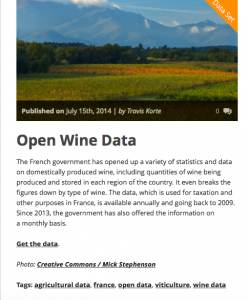This week’s readings were focused on the open cultural data museums present and how they are being used for visualization studies and analysis. In particular, Mia Ridge’s “Where Next for Open Cultural Data in Museums” highlighted how the community can interact with projects and art pieces better because they are given access to the open cultural data and linked data. Open cultural data refers to any data that cultural institutions make public and accessible, for example museum images and captions. Meanwhile, linked data is another way of sharing information however, if requires other sources that relate to the data being described as well – for example the “Cooper-Hewitt’s Collection Color History”.
I thought it was intriguing how the idea of open cultural data could not only be applied to museums but also to any type of information source whether it be science, epidemiology, sports, food, or wines. In the past for my job, we have had to learn a lot about different alcohols – especially beers and wines. As a waitress, we would have to be able to explain why certain wines were priced differently than others and what the significance was behind that. When learning about different wines – I found a open data website for them.

This “Open Wine Data” website has been compiled from public data released from the French government about the statistics of domestically produced wine. The data includes the quantities of wine being produced, the annual figures of wine, and where it is being stored in each country. This data helps explain for example why a 1984 Bordeaux is so sought after. During that year, the sales were really high – and the way the wine was made in particular makes it really special.
I thought open data in this situation was really interesting, because I never really expected it to be used to explain the reasoning why some wines are better than others.
Wow! I think that’s a pretty cool open data source about wines. I followed your link, and I was actually a bit surprised that it’s made available by the Center For Data Innovation, who typically focus on political data. So this was pretty unique 🙂
I really enjoyed your example! I was not aware they had a database for wines, and am curious to see if there are any public ones available for other foods e.g. cheeses and chocolates. I am not a wine expert by any means, and it would be so educational to see some of this information visualized and explained to me in a more accessible way (rather than doing my own extensive research or digging through a database).
That is a very interesting example. It is cool that the French government makes that public so that people are more informed about what they are consuming and why it is priced the way it is. However, do you think this is as helpful in the museum world? Is data being made public to give viewers a sense of autonomy and input into the museum or is it just there because it can be?
I actually had to use the same database for my internship at Snapchat when we did a live story about wine makers in Europe last November and completely forgot about it. I didn’t think this would be classified as “open cultural data” in the same way as the Tate’s Turner data, but it definitely is. It’s actually really cool to see that open cultural data has a practical use outside of academic purposes.
I love that this blog post presented a open data source that helps to support cultural trends.This type of information and this approach to cultural data is, for me, one of the core purposes of digital humanities. Projects like this are furthering the Digital Humanities world because it provides an example for how to translate culture into a digital space.
This is an amazing example about how open data can serve to enhance a person’s understanding of a product. I wonder, however, if it has the same implications when looking at art, which isn’t mass produced, where wine is. I fear that placing too much significance on cultural data when referring to an art piece would lead to misunderstandings about why the work is important.